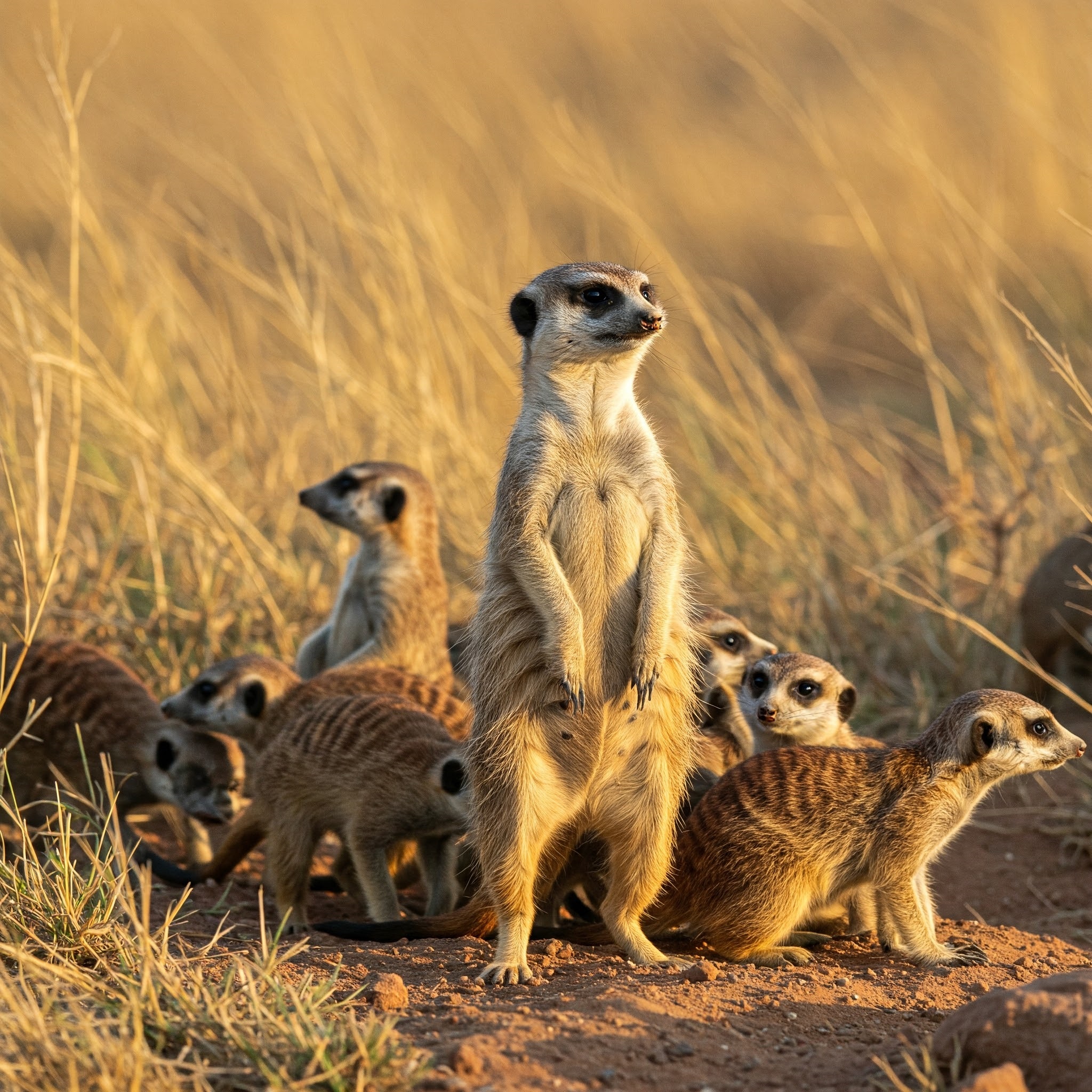What can we learn from fierce female animal leaders who dominate social structures and nurture their communities?
In the natural world, numerous animal species display female-centered societies where matriarchs assume crucial roles that extend beyond reproduction. These societies often feature intricate social structures, with females taking the lead in protecting and nurturing their communities.
Female dominance is evident in various species, including elephants and hyenas, where matriarchs have a significant influence on group dynamics, resource distribution, and conflict resolution. These females not only engage in mating but also help maintain social harmony, which promotes their group’s stability. Their leadership often involves teaching younger generations essential survival skills, foraging techniques, and social behaviors necessary for the community’s success.
Let’s explore the intriguing dynamics of female-centered societies, highlighting how these influential matriarchs shape their communities and enhance the overall health of their ecosystems. By examining these roles, we deepen our understanding of the complexities of animal behavior and the significance of female leadership in nature.

1. Matriarch Elephants
Female elephants hold a special place in their social structure, primarily as matriarchs who lead their herds. The oldest and most experienced female often steps up as the leader, guiding her group through essential decisions about migration, feeding, and finding water sources. These matriarchs possess a wealth of knowledge about their environment, which is crucial to the herd’s survival, especially during challenging times.
Female elephants form strong social bonds within the group, nurturing and protecting their young while teaching them essential survival skills. They show incredible empathy and support for each other, often comforting those in distress. Moreover, female elephants play a vital role in keeping the herd together, ensuring that family ties stay strong and that the group works in harmony, which highlights their sophisticated and caring nature within society.
2. Queen Bees
The queen bee is the heart of the hive, playing a vital role in keeping the colony thriving. She works tirelessly to lay eggs, producing an impressive number, up to 2,000 each day during peak seasons, ensuring the colony grows and continues to flourish. With her special pheromones, she helps maintain a sense of harmony, gently signaling to the worker bees to keep everything running smoothly. This chemical communication fosters a sense of togetherness, guiding behaviors like foraging, nursing, and hive maintenance. Plus, the queen’s presence and health have a direct impact on how productive and spirited the colony is, making her the key figure that beautifully unites and sustains the hive’s intricate social structure.
3. Orca Matriarchs
Female orcas, also known as killer whales, play a crucial role as matriarchs in their pods, helping to shape their families’ social structure and ensuring their survival. Usually, the oldest females lead their family groups, which can include multiple generations, such as their offspring and grandchildren. Their vast knowledge of hunting techniques, migration routes, and social dynamics is essential for the health and survival of the entire pod.
Killer whales communicate through a variety of vocalizations, skillfully guiding the pod during hunts and ensuring that everyone works together harmoniously. They also offer valuable emotional support, which nurtures strong social bonds among pod members. As natural leaders, female orcas play a crucial role in navigating challenges like shifts in food availability and environmental conditions. Their presence is vital for maintaining the pod’s cohesion and prosperity, making them truly central figures in their vibrant community.
4. Lionesses
Male lions play a crucial role in reproductive rights and sometimes in defending their pride, but that’s about where their influence in the group ends. Lionesses are in the center of the social network and are essential to their hunting strategies. These remarkable females come together as a team to hunt, using their incredible strength and agility to catch prey such as antelopes and zebras. Their teamwork during hunting enhances their success, providing ample food for everyone in the pride.
Lionesses play a vital role in nurturing and protecting the cubs, nurturing strong social bonds within the pride. They love to engage in social grooming and playful activities, which not only help maintain unity but also reduce tensions among the members. As the primary caregivers and hunters, lionesses truly embody the strength and resilience of the pride, making them central figures in the social and survival dynamics of their group.

5. Alpha Female Meerkat
The alpha female meerkat plays a crucial role in meerkat society, serving as the primary leader and decision-maker for her group. As the dominant female, she not only takes charge of breeding, helping to secure the family lineage’s future, but she also leads the group on foraging adventures, skillfully guiding them to food sources while keeping a watchful eye out for predators. Her contributions truly help keep the group safe and thriving.
Her role goes beyond just being a leader. She creates a sense of community by engaging in caring and affectionate interactions with her fellow members. The alpha female also thoughtfully delegates tasks, such as babysitting and sentry duty, so that everyone can contribute to the group’s well-being. By nurturing order and collaboration within the mob, the alpha female is truly vital for the group’s survival and success.
6. Octopus Mothers
Octopus mothers truly shine as dedicated caregivers, showcasing a unique and heartfelt nurturing role in their world. After they mate, a female octopus lays thousands of eggs and commits herself entirely to protecting and nurturing them. She lovingly guards her eggs, making sure they get enough oxygen and stay safe from predators. In this crucial moment, the mother prioritizes her children’s needs over her own, even skipping meals for their well-being.
When the eggs hatch, the mother octopus typically dies, demonstrating her remarkable sacrifice for the sake of her young ones. This deep commitment truly showcases the vital role she plays in helping her babies survive. Although her nurturing time is brief, it makes an enormous difference in ensuring the species continues, revealing the fascinating complexities of octopus life cycles.
7. Female Chimpanzees
Female chimpanzees are crucial to their communities, serving as the foundation of social structure and providing care. Often serving as leaders, these matriarchs navigate their families through environmental challenges. They engage in key activities, such as food foraging, teaching essential survival skills to their young, and fostering community bonds. Their strong maternal instincts promote the welfare of their offspring, while their influence shapes the behaviors of younger members. By creating social networks, female chimpanzees enhance the stability and success of their groups, underscoring the significance of female leadership in the animal kingdom.
In “My Life with the Chimpanzees,” distinguished primatologist Jane Goodall recounts her transformative experiences studying these fascinating beings. This memoir sheds light on the intricate social dynamics of chimpanzees, emphasizing the crucial contributions of female leaders within their groups. Goodall’s engaging narrative highlights the emotional richness and cognitive abilities of these creatures, illustrating the matriarchs who nurture and support their families.
8. Spotted Hyena Matriarchs
Spotted hyena females are central to the intricate social structure of their clans. These dominant matriarchs lead groups that typically include several generations of related females and their young. Their leadership, marked by strength and wisdom, directs the clan in hunting tactics and defending their territory.
Female hyenas are crucial for finding food and passing on essential skills to younger members. They frequently determine the clan’s movements and how to react to threats. Moreover, a matriarch’s status affects the clan’s hierarchy, which in turn influences opportunities for mating and access to resources. Their capacity to foster social cohesion and collaboration is crucial for the clan’s survival and success in a competitive environment.

9. Emperor Penguin Mothers
Emperor penguin mothers are crucial to their species’ survival, especially during the challenging Antarctic breeding season. Once they lay a single egg, the mother delicately places it on the father’s feet, where it is incubated for roughly two months. Throughout this period, the mother undertakes a lengthy journey to locate food, frequently covering vast distances to feed her young.
When she comes back, the mother lovingly resumes her caregiving duties, providing her chick with nutrient-rich regurgitated food. The special bond between mother and chick is vital for survival, ensuring the chick gets all the nourishment and warmth it needs. This wonderful teamwork in parenting beautifully illustrates the resilience of emperor penguins, highlighting the mother’s crucial role in nurturing and safeguarding the next generation against tough environmental challenges.
The common view of male-dominated hierarchies in the animal kingdom often neglects the complex and vital roles of females. The energy and resources required for childbirth lead to the development of dominance as a key survival strategy in many species. This nuance indicates that social structures are shaped not just by gender but by a range of factors, including maternal care and leadership. As we delve into these dynamics, it becomes clear that the idea of “Alpha” goes beyond traditional gender roles.
If you want to read something else from Pet Compilation, this article has some fascinating facts: 7 Animals That Help Fight Climate Change (Did You Know That?).












